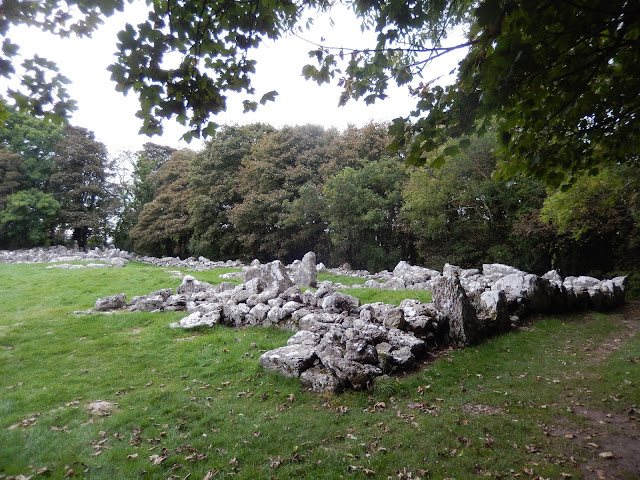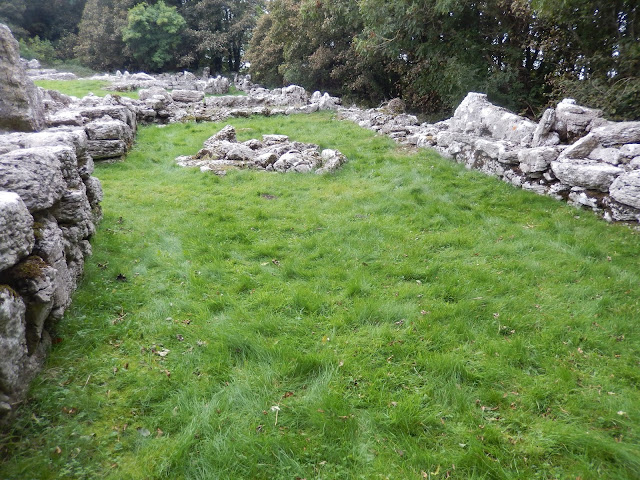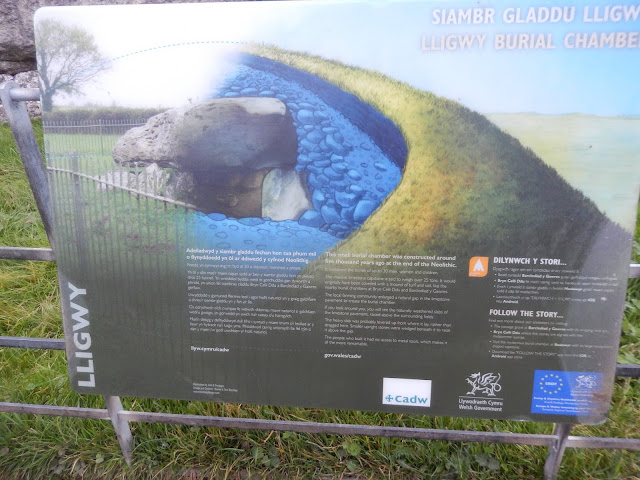 |
| Blackberries, ripe and ripening, in the hedge near Ty Dderw |
 |
| Part of the farmstead ruins, with late winter trees (taken in 2015) |
 |
| Similar shot of the ruins, showing early autumn sycamore, ash and beech (2016) |
When I was last at the site, I discovered that one of the buildings was used as a smithy. I found this discovery exciting, because my main character was the son of a blacksmith and I have come to feel blessed by such synchronicities. When I checked out the hut, I liked the fact that you stepped into it as if stepping into the Otherworld, a place of the gods. This discovery also felt appropriate to the world of my story. (Further research revealed that two of the rectangular dwellings on the site had evidence of smelting. It seems that, in imitation of Roman architecture, the rectangular buildings were used for workshops and animals, while the roundhouses were dwellings, a Celtic preference.)
 |
| Plan of Din Lligwy (source) |
 |
| The entrance into the main smithy (top right hand corner of the above diagram) |
 |
| The remains of a possible forge near the entrance |
 |
| Display board at the site |
 |
| Artist impression of Din Lligwy (source) |
 |
| Another artist impression, from a different direction–same as diagram above (source) |
 |
| Detail, showing the bloomeries |
 |
| A bloomery in operation. The bloom will eventually be drawn out of the bottom hole. (Source) |
After I had spent time wandering around the farmstead taking photos, measuring the width of stone walls, and making notes of trees and plants, I started back to Ty Dderw, but not before stopping off at the Neolithic Lligwy Burial Chamber to pay my respects to the ancestors of those who founded the farmstead. I sat inside the tomb for a long while to reflect on my intentions for the novel and to absorb the silence, which, unlike last year, no RAF fighter jets disturbed.
 |
| Robin singing as night approaches |
 |
| Artist impression of original tomb and mound |
 |
| The massive capstone over the tomb |
 |
| Sunset over Moelfre, the coastal village near Ty Dderw |
That’s it for now. As always, I welcome any comments.

Fascinating. I'm enjoying seeing your photos Earl.
Thanks, Liz. I hope your new project is bubbling along nicely.
eBook: Memory of Fire
The following might be of interest:
Free ebook version (PDF, epub and mobi) of Memory of Fire is now available at
http://www.unglue.it/work/193933
Book description:
Memory of Fire is a collection of poems composed by Clare Maynard while traveling between Wales and Germany and in other parts of Europe over a period of ten years. The majority of the poems were written in cafés in Berlin during the winter months, drawing on past memories.
The collection captures the different atmospheres of rural and urban landscapes, evoking both myth and the historical changes experienced by those who live inside and outside of the towns and cities, also how countryside and city can represent transient and static cultures, some of them remaining unchanged throughout the years.
Grüße,
Kurtis
How enriching this must be for you and your novel.
Hi Nadine, This travelling research is goving me plenty of material for the novel and is certainly enriching my soul. Of course, all I have to do now is writer the novel so I have an excuse to come back in the future to promote it. 🙂